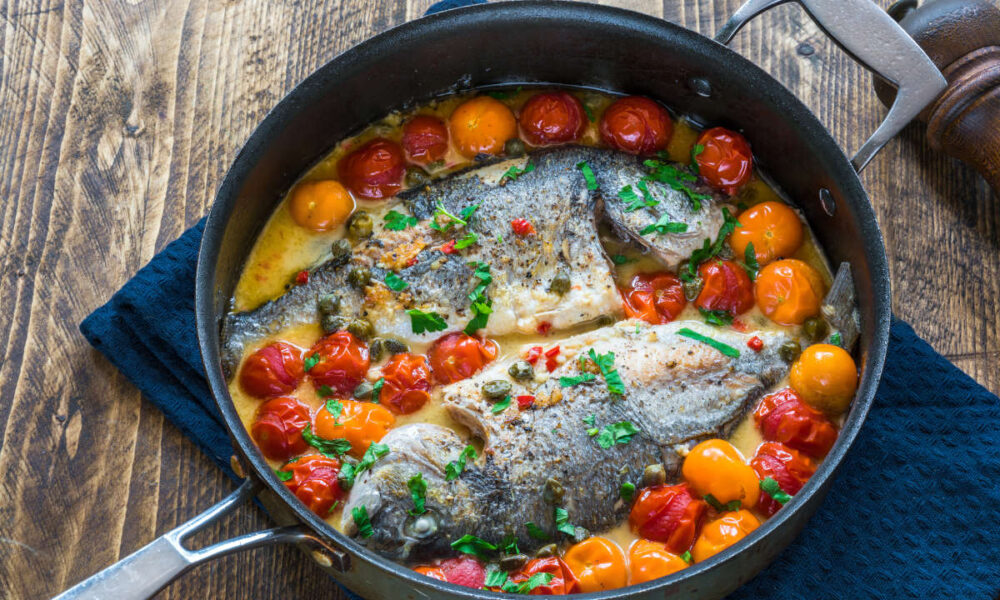Recipes
Crazy water, the simplicity of Mediterranean taste: history and recipe!

Crazy water is an ancient fish preparation technique, typical of Southern Italy. Let's find out what it is and why they say that water "goes crazy"!
Crazy water is a fish preparation technique that has its roots in the tradition of the seaside regions of southern Italy and consists of cooking medium-sized fish in water, salt, oil, garlic and cherry tomatoes. At the end of the dish, finely chopped parsley is added which makes it unique.
Acqua pazza is usually made with a white sea fish such as sea bass or sea bream, but also red snapper, perch, bream, sea bream, sea bream, San Pietro, gurnard or sea bass. The crazy water cooking method, as well as being suitable for many different types of fish, is very healthy and low-calorie. In fact, only 74 kcal are calculated for every 100 g of product (obviously the data varies depending on the fish but the average is still very low).
In today's recipe we will cook sea bream in crazy water: let's see how it's done together!
Preparation of fish in crazy water
The ingredients are few, but in modern versions other aromatic herbs, chili peppers and sometimes capers and olives are sometimes added. Preparing fish in crazy water is really simple.
- Once you have cleaned the fish (for convenience you can ask the fishmonger to do it for you), focus on the cherry tomatoes. Run them under cold water and clean them well. Then cut them into two hemispheres and again, until you obtain quarters.
- Take a medium-sized pan and pour a drizzle of oil into it, add the garlic and then the cherry tomatoes. Let them go for a few minutes, then add the aromatic herbs and salt.
- It's time for the fish: put it in the pan and add the white wine, always keeping the flame alive. Once the alcohol has evaporated and everything has started to boil again, lower the heat. Cover the pan with a lid and leave to cook slowly for about twenty minutes.
- Turn the sea bream several times and, if necessary, add hot water. The fish will be ready when the eye is white . Be careful not to overcook it! It would become dry and unpleasant.
- Once ready, remove from the heat and add the finely chopped raw parsley . Enjoy your meal!
And if you want to vary it a bit, also try preparing a sea bass or sea bass in crazy water, each fish will have its own unique and distinct flavour !
The history and origin of crazy water
The first written evidence of the use of this cooking technique dates back to the end of the 19th century . According to these written sources, "crazy water" cooking was typical of the poor fishermen of the seaside areas of Campania, Lazio, Sicily, Calabria and Puglia who, often with makeshift ingredients, prepared their meals inside their fishing boats.
Since salt then had a high cost, a "crazy" cost, the fishermen simply replaced it with sea water, which was naturally salty. Then they took some cherry tomatoes, garlic and brought with them a sprig of parsley. Finally, obviously, they exploited the fish caught during their trip to the sea. Impossible to think of something more fresh, Mediterranean and spontaneous! Crazy water is a symbol of quality in the simplicity of Italian cuisine.
Although the origin of this dish is often attributed to the Neapolitan culinary culture, in reality it seems that it was a Mediterranean phenomenon and involved many Italian coastal regions.
According to other testimonies, the recipe for fish with crazy water only became famous in the 1960s thanks to Totò. In fact, the star, adoring this preparation, requested it in the best restaurants on Capri and so the dish became more and more popular until it became a real trend.
If you love this fish we can only recommend the baked sea bream with potatoes!
storage
Fresh fish should be enjoyed as soon as it is ready. So we don't recommend freezing this recipe in the fridge either: if you really can't finish the whole dish you can keep it in the fridge for a maximum of a few hours . We do not recommend freezing.
Riproduzione riservata © - WT